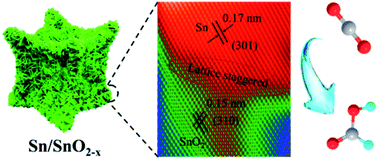Defect evolution of hierarchical SnO2 aggregates for boosting CO2 electrocatalytic reduction†
Abstract
To efficiently convert CO2 into high-value added products via the electrocatalytic reduction, the rational regulation of surface defects (e.g., oxygen vacancies) and the interfacial structure of electrocatalysts are crucial but still challenging. Herein, a feasible strategy is presented to manipulate oxygen vacancies and interfacial boundaries on hierarchical tin oxide aggregates via a thermal reduction process. The optimized Sn/SnO2-2h electrocatalyst exhibited the maximum faradaic efficiencies (FEs) of 92.5 and 96.4% for C1 products (FEC1) in the H-type cell and the flow cell, respectively. Online differential electrochemical mass spectrometry confirmed the lower onset potential for the electrocatalytic CO2 reduction reaction (ECRR) in comparison with the pristine SnO2. With the defect evolution from oxygen vacancies (Ovacs), the formation of Sn/SnO2 with favorable interfacial features is crucial to achieve an enhanced performance. More importantly, the in situ characterization studies and density functional theory (DFT) calculations revealed that the synergistic effect of both residual Ovacs and the interfacial structure is responsible for the energy favorable reduction of carbon dioxide via proton-coupled electron transfer, thus improving the selectivity for formate generation. This facile strategy for modulating surface defects provides an ideal approach to guide the future designs of ECRR catalysts.



 Please wait while we load your content...
Please wait while we load your content...